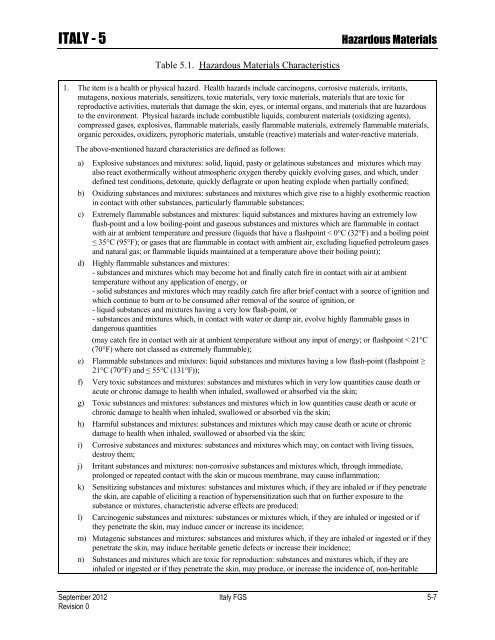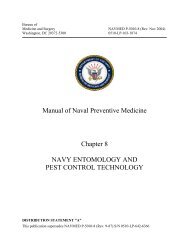ENVIRONMENTAL FINAL GOVERNING STANDARDS ITALY
ENVIRONMENTAL FINAL GOVERNING STANDARDS ITALY
ENVIRONMENTAL FINAL GOVERNING STANDARDS ITALY
You also want an ePaper? Increase the reach of your titles
YUMPU automatically turns print PDFs into web optimized ePapers that Google loves.
<strong>ITALY</strong> - 5 Hazardous Materials<br />
Table 5.1. Hazardous Materials Characteristics<br />
1. The item is a health or physical hazard. Health hazards include carcinogens, corrosive materials, irritants,<br />
mutagens, noxious materials, sensitizers, toxic materials, very toxic materials, materials that are toxic for<br />
reproductive activities, materials that damage the skin, eyes, or internal organs, and materials that are hazardous<br />
to the environment. Physical hazards include combustible liquids, comburent materials (oxidizing agents),<br />
compressed gases, explosives, flammable materials, easily flammable materials, extremely flammable materials,<br />
organic peroxides, oxidizers, pyrophoric materials, unstable (reactive) materials and water-reactive materials.<br />
The above-mentioned hazard characteristics are defined as follows:<br />
a) Explosive substances and mixtures: solid, liquid, pasty or gelatinous substances and mixtures which may<br />
also react exothermically without atmospheric oxygen thereby quickly evolving gases, and which, under<br />
defined test conditions, detonate, quickly deflagrate or upon heating explode when partially confined;<br />
b) Oxidizing substances and mixtures: substances and mixtures which give rise to a highly exothermic reaction<br />
in contact with other substances, particularly flammable substances;<br />
c) Extremely flammable substances and mixtures: liquid substances and mixtures having an extremely low<br />
flash-point and a low boiling-point and gaseous substances and mixtures which are flammable in contact<br />
with air at ambient temperature and pressure (liquids that have a flashpoint < 0°C (32°F) and a boiling point<br />
≤ 35°C (95°F); or gases that are flammable in contact with ambient air, excluding liquefied petroleum gases<br />
and natural gas; or flammable liquids maintained at a temperature above their boiling point);<br />
d) Highly flammable substances and mixtures:<br />
- substances and mixtures which may become hot and finally catch fire in contact with air at ambient<br />
temperature without any application of energy, or<br />
- solid substances and mixtures which may readily catch fire after brief contact with a source of ignition and<br />
which continue to burn or to be consumed after removal of the source of ignition, or<br />
- liquid substances and mixtures having a very low flash-point, or<br />
- substances and mixtures which, in contact with water or damp air, evolve highly flammable gases in<br />
dangerous quantities<br />
(may catch fire in contact with air at ambient temperature without any input of energy; or flashpoint < 21°C<br />
(70°F) where not classed as extremely flammable);<br />
e) Flammable substances and mixtures: liquid substances and mixtures having a low flash-point (flashpoint ≥<br />
21°C (70°F) and ≤ 55°C (131°F));<br />
f) Very toxic substances and mixtures: substances and mixtures which in very low quantities cause death or<br />
acute or chronic damage to health when inhaled, swallowed or absorbed via the skin;<br />
g) Toxic substances and mixtures: substances and mixtures which in low quantities cause death or acute or<br />
chronic damage to health when inhaled, swallowed or absorbed via the skin;<br />
h) Harmful substances and mixtures: substances and mixtures which may cause death or acute or chronic<br />
damage to health when inhaled, swallowed or absorbed via the skin;<br />
i) Corrosive substances and mixtures: substances and mixtures which may, on contact with living tissues,<br />
destroy them;<br />
j) Irritant substances and mixtures: non-corrosive substances and mixtures which, through immediate,<br />
prolonged or repeated contact with the skin or mucous membrane, may cause inflammation;<br />
k) Sensitizing substances and mixtures: substances and mixtures which, if they are inhaled or if they penetrate<br />
the skin, are capable of eliciting a reaction of hypersensitization such that on further exposure to the<br />
substance or mixtures, characteristic adverse effects are produced;<br />
l) Carcinogenic substances and mixtures: substances or mixtures which, if they are inhaled or ingested or if<br />
they penetrate the skin, may induce cancer or increase its incidence;<br />
m) Mutagenic substances and mixtures: substances and mixtures which, if they are inhaled or ingested or if they<br />
penetrate the skin, may induce heritable genetic defects or increase their incidence;<br />
n) Substances and mixtures which are toxic for reproduction: substances and mixtures which, if they are<br />
inhaled or ingested or if they penetrate the skin, may produce, or increase the incidence of, non-heritable<br />
September 2012 Italy FGS 5-7<br />
Revision 0
















